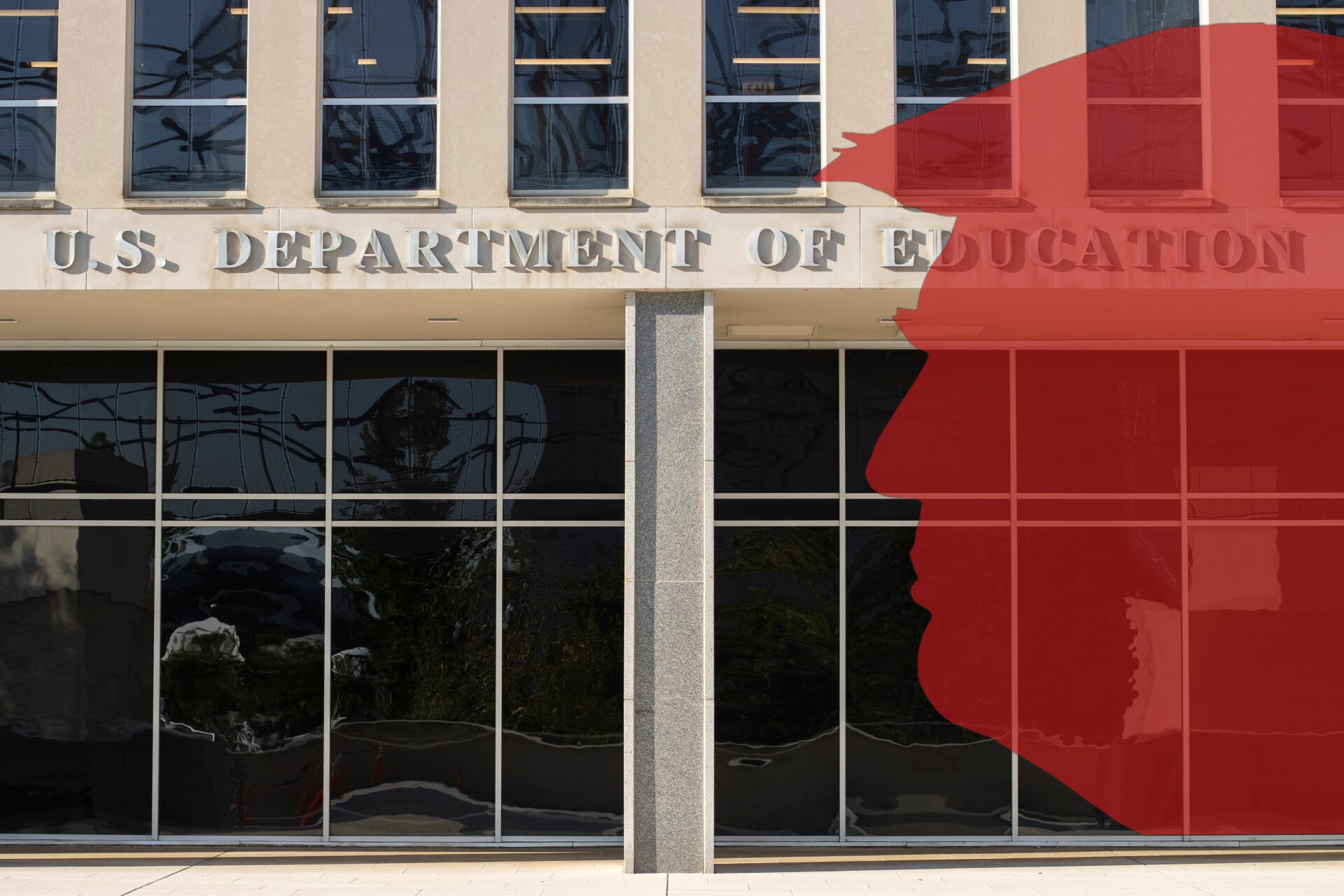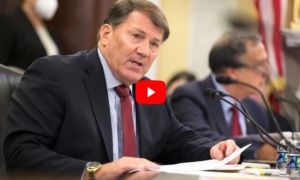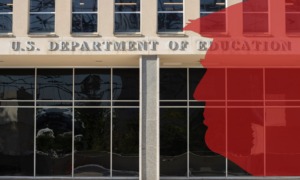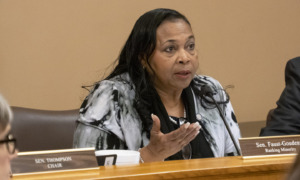![]()
The Trump administration has promised big changes, but the president can’t make them alone
![]()
This story was originally published by The Hechinger Report,
By now, you know about the endless speculation on whether the incoming Trump administration might close the U.S. Department of Education. It remains just that: speculation. Congress would have to be involved, and even a Senate and House controlled by the same party as President-elect Donald Trump would not necessarily go along with this idea.However, in a statement about his nomination of Linda McMahon for education secretary, Trump underscored his campaign pledge to disband the department, saying, “We will send Education BACK TO THE STATES, and Linda will spearhead that effort.”
The mere specter of shuttering an agency that commands more than $200 billion has led parents, students, teachers, policy experts and politicians to wonder about (and in some cases plan for) the possible effects on their children and communities.
Collectively, state and local governments spend far more on education than the federal government does. With federal dollars connected to many rules about how that money can be spent, however, the Education Department does play a significant role in how schools and colleges operate.
Deleting the agency would not undo federal law providing money for students in rural places, with disabilities or who come from low-income families, but doling out that money and overseeing it could get messy. This week, Republican Sen. Mike Rounds of South Dakota introduced a bill to unwind the Education Department and spread its work across other federal agencies.
The questions
The Hechinger Report tried to answer some of the questions raised by the possible dismantling of the department, consulting experts and advocates on student loans, special education, financial aid, school lunch and beyond.
Nothing is out of the realm of possibility, however complicated. A much smaller agency that guided Congress on science, the Office of Technology Assessment, simply had its budget set to zero back in 1995 — and just like that, it was gone.
The Education Department, created in 1979, reaches far wider and deeper, into essentially every community nationwide. Its impact is felt not so much in what students are learning every day but whether their schools or the government can:
- pay for the special equipment or training that might be essential for some students with disabilities;
- pay for an extra teacher to work with struggling readers;
- pay for a student from a low-income household to get federal grant money for college;
- forgive federally backed college student loans.
At the same time, many education programs, as well as some that touch schools, exist entirely outside of the Education Department. For example, it doesn’t run or oversee:
- the education of students whose parents live on military bases, managed by the Defense Department;
- the education of students who attend school on Native American reservations, managed by the Interior Department;
- school lunch or breakfast programs, managed by the Agriculture Department;
- the biggest child care programs for low-income families, managed by the Department of Health and Human Services.
Early education
What would happen to federal early education programs?
The most well-known and biggest federal early childhood programs, Head Start and the Child Care Development Block Grant, are not a part of the Education Department — they’re administered by the Department of Health and Human Services. So they would not be directly affected by an Education Department shutdown.
But Education does oversee and pay for some smaller early learning programs and early childhood research. For example, the Preschool Development Grant — Birth through Five, provides funding for state early learning programs and is overseen jointly with HHS. Other programs, such as Promise Neighborhoods and Full Service Community Schools, also address the early years and family support.
The Education Department also is home to several research centers that focus on young children, many of which conduct long-term students or research aimed at improving the lives of infants and toddlers with disabilities. Those programs, if they were not cut, would have to move to another agency.
K12 Education
What happens to Title I and other money that the department doles out?
Closing the Education Department would not undo it. Title I — a program established in 1965 that provides money to schools with large numbers of low-income students — is part of federal law. If the Education Department were to be eliminated, the most likely scenario is that Title I money would flow through another federal agency. Major cuts to the program are unlikely.
While Trump and others close to him have said they would like to cut federal education funding streams like Title I, any cuts would need to go through Congress — where that funding has broad political support among both Republicans and Democrats. That is especially true for Title I: Almost all school districts in the country get a share of that money.
So it’s unlikely Title I “would ever see an actual cut, and certainly not a substantial cut,” said Nora Gordon, a professor of public policy at Georgetown University’s McCourt School of Public Policy. She said even members of Congress who are hostile to other federal programs that allocate funds for low-income families would be reluctant to defund Title I.
[Related: Unlikely Trump can actually eliminate Education Department, experts say]
Do I have to worry about special education?
There would be bureaucratic upheaval if another agency took on oversight of education of students with disabilities, but the special education law itself, and the money allotted to it, would not change without an act of Congress.
The law now known as the Individuals with Disabilities Education Act was passed in 1975, four years before the Education Department was formed. At that time, it was administered by the Department of Health, Education and Welfare (now known as the Department of Health and Human Services department).
About 7.5 million children are now served under the IDEA. For fiscal 2024, the department oversaw about $14 billion in funding for school-aged children, with smaller pots of money going to infants, toddlers, and other special education-related programs.
Through the Education Department, the government sets rules for states, districts and schools about how children should be identified for possible disabilities and how families, parents and schools should work together to create a child’s “individualized education program,” a menu of the supports and services they should receive.
Does this mean everyone will get a private school voucher?
Regardless of the future of the Education Department, Trump could, with the support of Congress, take some action to expand school choice nationwide. Republicans in their official party platform made universal school choice, in every state, a top priority. The idea didn’t go far under Trump’s first education secretary, but political headwinds may make it easier for him to achieve some policy wins this time.
[Related: What education could look like under Trump and Vance]
During the first Trump administration, then-Secretary Betsy DeVos pushed to expand school choice, largely through charter schools and private school vouchers. Congress, however, ignored her budget request in 2018 for $400 million to fund their expansion. A year later, DeVos pitched $5 billion in tax credits for individuals and businesses that contribute to scholarships for students to attend private schools. Trump resurrected the idea in early 2020, and again as an option for parents frustrated with prolonged school closures during the pandemic. A bill to create the tax credits died in committee.
As part of the agenda for his next term, Trump has pledged to allow families with a 529 college savings plan to spend up to $10,000 a year per child on homeschool education. The GOP also wants to expand education savings accounts, or ESAs — a polarizing program that allows families to pull their children out of public school and use a portion of state per-pupil funding on private school tuition, homeschool supplies and other educational costs. At least a dozen states since 2020 have created ESA programs, with some offering universal enrollment regardless of a family’s income level and with few restrictions on taxpayer money being spent on religious education.
Rural opposition has stalled such legislation in states like Texas, and voters in November rejected school choice measures on ballots in three states. But in recent years, the Supreme Court has expanded the religious rights of parents and sectarian schools. Trump’s next education secretary is also likely to have an easier time clearing school choice legislation with Republican control of both the House and Senate.
[Related: School choice may have its biggest moment yet]
What would happen to school lunch, and free and reduced-price school lunches?
Nothing. Eliminating the Education Department would likely have little or no impact on the school lunch program. The U.S. Department of Agriculture, not the Education Department, runs the vast National School Lunch Program, although the data collected by schools about the number of students who qualify for low-cost or no-cost breakfast and lunch powers a lot of the education agency’s work. About 30 million kids participate in the program on a given school day — including students at public charter schools and some nonprofit private schools.
During Trump’s first term, as part of a collection of pandemic-related measures, he approved providing school lunches to all students, regardless of their household income. Several states have since kept up that effort since the pandemic option expired, offering free meals to all students no matter their family earnings. And a growing number of schools in other states now offer meals to all students if a large enough number qualify for free lunches. Earlier this year, a Republican budget proposal, called Fiscal Sanity to Save America, said that option should be eliminated.
Trump has distanced himself from Project 2025, created by the conservative Heritage Foundation, but that document also calls for reining in spending on school meals. “Federal school meals increasingly resemble entitlement programs that have strayed far from their original objective and represent an example of the ever-expanding federal footprint in local school operations.”
What happens to education research and the tracking of students’ academic achievement?
The work of the Institute of Education Sciences, the research and statistics arm of the Education Department, is mandated by law and would not disappear overnight even if the agency were abolished. IES collects and aggregates data from more than 19,000 school districts around the country to give the public a national picture of our decentralized educational system, from counting the number of students and dollars spent on schools to tracking class sizes and years teachers stay in the job. IES disburses millions of dollars each year to researchers to develop new ideas for improving instruction, and it evaluates programs afterward. One-fourth of IES’s $800 million a year budget goes to administering the National Assessment of Educational Progress, or NAEP, which is an important yardstick for measuring academic achievement among fourth and eighth graders.
All three of these functions — statistics collection, research and assessment — theoretically could be transferred to other agencies, according to former IES director Mark Schneider, whom Trump appointed to a six-year term during the former president’s first term. Education research could shift to the National Science Foundation, which already awards grants for educational research along with the Education Department. The statistics unit, also known as the National Center for Education Statistics, could be folded into the Bureau of Labor Statistics, which is the main statistical agency of the federal government. A new home for the NAEP test is less obvious.
Schneider said that talk of eliminating the Education Department may invite more scrutiny into what its research arm does. Advocates could try to capitalize on this scrutiny as an opportunity to lobby for an overhaul of the research division, he said.
Higher Education
What happens to student loans if the Education Department is abolished?
Student debt won’t disappear even if the Education Department does. The federal agency contracts with the loan servicers that manage nearly $2 trillion in student loan debt and oversees the programs that can lead to loans being forgiven, such as for teachers and people who work in public health.
“The terms and conditions of the loans don’t change just because the agency changes,” said Betsy Mayotte, president of the Institute of Student Loan Advisors, which offers advice and guidance on student loans to borrowers. If there is no Education Department, it’s likely that student loan oversight and debt collection would shift to the Treasury Department. “I expect that at least initially the servicers wouldn’t even change.”
Aside from that,Republicans in Congress, who will soon control both chambers, have proposed a College Cost Reduction Act, which would increase the amount of federal Pell grants for third- and fourth-year college students pursuing bachelor’s degrees in fields considered to be in high demand. It would also simplify the student loan repayment process and end certain kinds of loans available to parents, graduate students and low-income learners. It would hold colleges and universities, rather than taxpayers, responsible for loans on which their students have defaulted.
The Biden administration’s relentless and embattled attempts to forgive some student loan debt are almost certain to come to an abrupt end. Many have been blocked by courts anyway, and Trump and his allies have characterized them as an unfair transfer of wealth from people who didn’t go to college to people who did.
What about grants and aid for paying for college, and the FAFSA?
Even without an Education Department, it is unlikely that the Pell grant — which most low-income students use to help pay for college — would disappear. Congress controls who is eligible for Pell, so the Trump administration couldn’t decide on its own to change or take away the grant. Pell has long had bipartisan support in Congress, and it is very unlikely that a Republican-controlled Congress would get rid of a grant that is relied on by so many constituents.
House Republicans have, however, proposed changes to eligibility and the award amount. A version of the College Cost Reduction Act has a chance of passing since Republicans will soon control Congress. The bill would peg the Pell award to the median cost of a college program, instead of basing it on the particular cost of the program or college where a student is enrolled. In practice, this means students enrolled in a program that is more expensive than average, whether due to the price set by the institution or due to a higher cost of living in that area, could see their award reduced. In addition, the determination of financial need would no longer take into account a family farm where the family resides or a family-owned small business that has fewer than 100 employees.
McMahon, Trump’s nominee for education secretary, also supports changes to Pell. She wrote an opinion piece in September promoting what’s known as “short-term Pell.” Right now, for the most part, Pell can be used only to pay for education programs that last 15 weeks or more (about one semester). McMahon supports a bill, which has some bipartisan support, that would allow federal aid dollars to pay for short-term programs that train students for particular jobs.
Critics worry such an expansion could take Pell dollars away from traditional programs. They note many short-term programs (for example, welder and HVAC programs) are already Pell-eligible and that shorter programs, including many run by for-profit companies, often don’t have good results. A recent report showed no improvement in employment for students who used short-term Pell.
While last year’s FAFSA rollout was broadly criticized, there seems to be no appetite to further complicate students’ ability to access federal financial aid. In fact, the College Cost Reduction Act includes a requirement that would simplify and standardize college financial aid offers so that students have an easier time understanding and comparing them.
***
This story about the Education Department was produced by The Hechinger Report, a nonprofit, independent news organization focused on inequality and innovation in education. Sign up for the Hechinger newsletter.




























